|
| Acanthocerus atricollis |
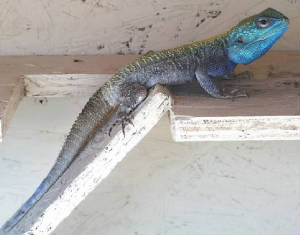
|
| Father of the babies below |
This page will show some of the agamids I
have been working with for
the last dozen
years. You will see the breeders
(parents)
as well as some of the babies
they've
produced. Even some of the eggs
as they
begin to pip and hatch their way out of
the eggs.
BLUE HEADED TREE AGAMA
The blue headed agama is one of
the most colorful with the males especially while displaying their vibrant blue heads and a mixtures of blues and limes from
their snouts to their tail tips.
| Acanthocerus atricollis |
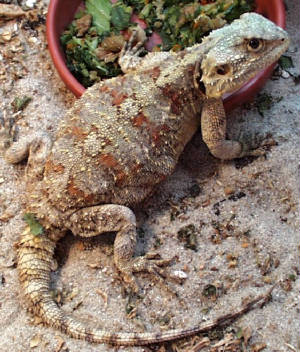
|
| Mother of the babies below |
| Acanthocerus atricollis |

|
| Hatched on 9/23/08 |
PAINTED AGAMA (AKA: CLOWN AGAMA)
The clown agama are one of the calmest of the L stellio groups. These
are my favorite as far as being quite personable and also very calm when handled. They vary in color phases with the darker being the more sought after. I have been
working primarily with the black phase clowns for a few years now and most of the babies I produce carry the dark color
gene due to some safe inbreeding.
| Laudakia stellio brachydactyla |
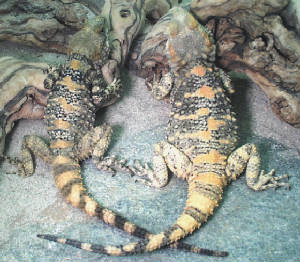
|
| Dark phase clown agama pair |
| L stellio brachydactyla |

|
| This dozen clown eggs hatched on 6/26/08 |
| L stellio brachydactyla |

|
| 2004 clutch showing color phase diversity |
ORANGE SPOTTED AGAMA
| Ladaukia stellio picea |
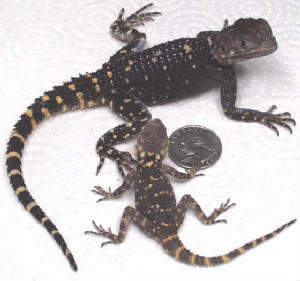
|
| Father and daughter |
The Ladaukia stellio picea
(orange spotted agama) are not as common here in the USA. I am one of the first breeders to produce cbb (captive bred and
born) babies here in the states which occurred this year (2008).
The males and females are similar in their dark brown color with the bright orange spots and bands from snout to tail tip. Some
males when sexually mature (as early as yearlings) will display a black ground color with some sprinkles of blue on their backs and blue color on their forearms and thighs.
In the first photo you can see my ALFA male
who displays just that blackish color as well as some blue spotting and also blue highlighting on the legs … very handsome
year old male. He shares the photo with one of his four month old offspring.
In the second photo you will see five of the fore mentioned male’s hatchlings just
hours after hatching. The third photo is of a clown agama and an orange spotted agama just after hatching. You can see the
size difference in the two stellio sub species as the orange spotted agama are smaller as are the eggs they hatch out
from.
| L stellio picea hatchlings |
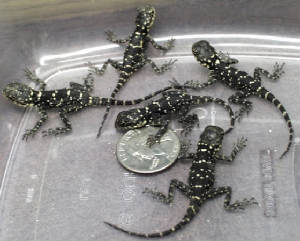
|
| hatched 6/27/08 |
|

